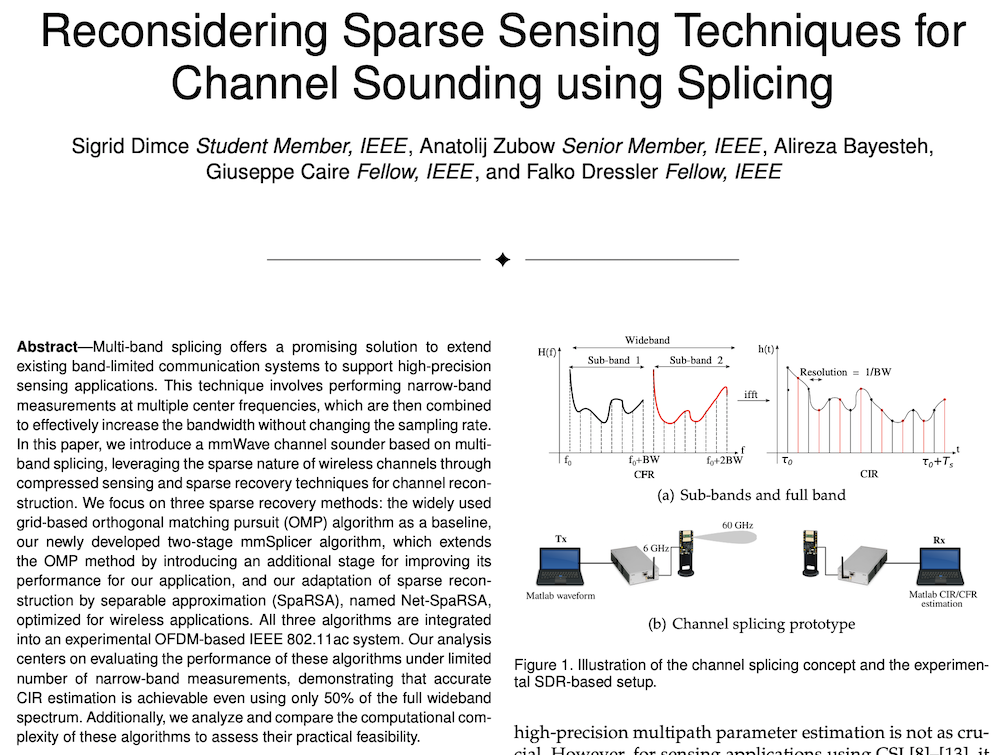Literature Database Entry
nabeel2016using
Muhammad Nabeel, Bastian Bloessl and Falko Dressler, "On Using BOC Modulation in Ultra-Low Power Sensor Networks for Wildlife Tracking," Proceedings of IEEE Wireless Communications and Networking Conference (WCNC 2016), Doha, Qatar, April 2016, pp. 848–853.
Abstract
Localization and tracking of small animals in the wild using sensor networks require nodes with ultra-low power consumption, which are particularly challenging to design. Here, we target the tracking of bats in their natural habitat and have to limit the weight of the mote to 2 g. To optimize the energy consumption in this scenario, the combination of data communication and ranging is essential. The limitations of the platform and the specific use case ask for a dedicated signal design. We start exploring the use of Binary Offset Carrier (BOC), which is known to be well suited for localization. In this paper, we concentrate on the data communication part of the system. We develop a BOC transceiver in Software Defined Radio (SDR) and perform simulations as well as lab measurements to evaluate its performance and compare it to Binary Phase-Shift Keying (BPSK), which is often used in low-power sensor systems. Most importantly, we conducted realistic field measurements to study the effects of multipath fading and shadowing. Our results clearly show that BOC is perfectly suited for ultra-low power communication in forest environments.
Quick access
Original Version ![]() (at publishers web site)
(at publishers web site)
Authors' Version ![]() (PDF on this web site)
(PDF on this web site)
BibTeX ![]()
Contact
Muhammad Nabeel
Bastian Bloessl
Falko Dressler
BibTeX reference
@inproceedings{nabeel2016using,
author = {Nabeel, Muhammad and Bloessl, Bastian and Dressler, Falko},
doi = {10.1109/WCNC.2016.7564858},
title = {{On Using BOC Modulation in Ultra-Low Power Sensor Networks for Wildlife Tracking}},
pages = {848--853},
publisher = {IEEE},
address = {Doha, Qatar},
booktitle = {IEEE Wireless Communications and Networking Conference (WCNC 2016)},
month = {4},
year = {2016},
}
Copyright notice
Links to final or draft versions of papers are presented here to ensure timely dissemination of scholarly and technical work. Copyright and all rights therein are retained by authors or by other copyright holders. All persons copying this information are expected to adhere to the terms and constraints invoked by each author's copyright. In most cases, these works may not be reposted or distributed for commercial purposes without the explicit permission of the copyright holder.
The following applies to all papers listed above that have IEEE copyrights: Personal use of this material is permitted. However, permission to reprint/republish this material for advertising or promotional purposes or for creating new collective works for resale or redistribution to servers or lists, or to reuse any copyrighted component of this work in other works must be obtained from the IEEE.
The following applies to all papers listed above that are in submission to IEEE conference/workshop proceedings or journals: This work has been submitted to the IEEE for possible publication. Copyright may be transferred without notice, after which this version may no longer be accessible.
The following applies to all papers listed above that have ACM copyrights: ACM COPYRIGHT NOTICE. Permission to make digital or hard copies of part or all of this work for personal or classroom use is granted without fee provided that copies are not made or distributed for profit or commercial advantage and that copies bear this notice and the full citation on the first page. Copyrights for components of this work owned by others than ACM must be honored. Abstracting with credit is permitted. To copy otherwise, to republish, to post on servers, or to redistribute to lists, requires prior specific permission and/or a fee. Request permissions from Publications Dept., ACM, Inc., fax +1 (212) 869-0481, or permissions@acm.org.
The following applies to all SpringerLink papers listed above that have Springer Science+Business Media copyrights: The original publication is available at www.springerlink.com.
This page was automatically generated using BibDB and bib2web.





